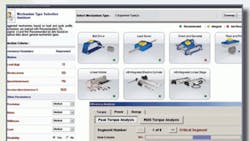New approaches improve efficiency
In manufacturing it's accepted that servomotors and servodrives are inherently energy efficient, and therefore are a logical component of sustainable machines. However, with rising energy costs and growing environmental concerns, some machine builders are turning to new solutions to make their machines operate even more efficiently. By incorporating advanced technologies and best practices into their organizations, manufacturers can meet sustainability goals while saving money and improving machine performance.
Mechatronic design
When applying motion control, manufacturers can now develop an optimized mechatronic design for machines with a more scientific approach — virtual modeling. Simulation reports the efficiency of both existing designs and new ideas, so designers can evaluate alternatives and identify the best design choices — often leading to smaller motors and drives. Although a design-build-test approach using physical prototypes serves the same purpose, it can be costly and slow.
Motion Analyzer software from Rockwell Automation helps machine builders realize the full benefits of mechatronic design by making it faster and easier to analyze, optimize, simulate, and select motion control systems. The software enables modeling of mechatronic systems in a virtual environment and predicts energy consumption and costs. A built-in system efficiency tool identifies what components consume motor power.
For example, if the transmission consumes excessive energy, engineers can leverage the tool to compare mechanical alternatives and choose an optimized design. From the software's embedded libraries of product data, engineers can select various motors, drives, electric cylinders, and linear stages to digitally prototype the design. This provides a fast, iterative design environment that provides early insight into how changing mechanisms in the system affects overall machine performance and energy use.
Servo technology
Servo technologies are increasingly common in many industries, so manufacturers have started powering linear machine motion with servo-controlled electric cylinders. This new solution often replaces traditional fluid power technology for greater machine flexibility and energy efficiency. Electric cylinders are linear rod actuators powered with an efficient combination of precision ball or roller screw mechanics and matching electrical servosystems. They provide highly repeatable, multi-set point, positioning and force control with stroke lengths from just a few millimeters to more than a meter in length, full actuation completed in less than a second, and anywhere from 50 to 2,500 lb continuous force. Electric cylinders are also quiet and energy-efficient.
In contrast, fluid-power systems tend to leak. In pneumatic actuators, this degrades efficiency, and in hydraulic actuators, this also impacts cleanliness. For the latter, disposal can also be expensive.
Direct driving
Incorporating direct-drive technology can also improve motion system sustainability. Replacing other transmissions with direct-drive motors improves operating efficiency by 60 to 90% on average, and can overcome drawbacks associated with traditional mechanical designs. Although gearboxes, transmissions, and belt-driven actuators may be less expensive in terms of initial investment, they exhibit backlash and compliance with typical losses of 30% or more.
Direct-drive technology practically eliminates these heat, friction, and noise losses, allowing the use of smaller motors and drives that require less electrical current. In addition, direct-drive motors are mounted to the payload, which eliminates the gearbox — to reduce compliance and backlash, and improve overall control.
Direct-drive technology can also be paired with mechatronic analysis to eliminate line shafts, timing belts, and other mechanical power transmission components. Case in point: One Rockwell Automation customer reduced energy losses 20% by replacing a line shaft with several individual servomotors electronically geared together. Tolerances were tightened, which reduced accumulated error, scrap, and maintenance.
